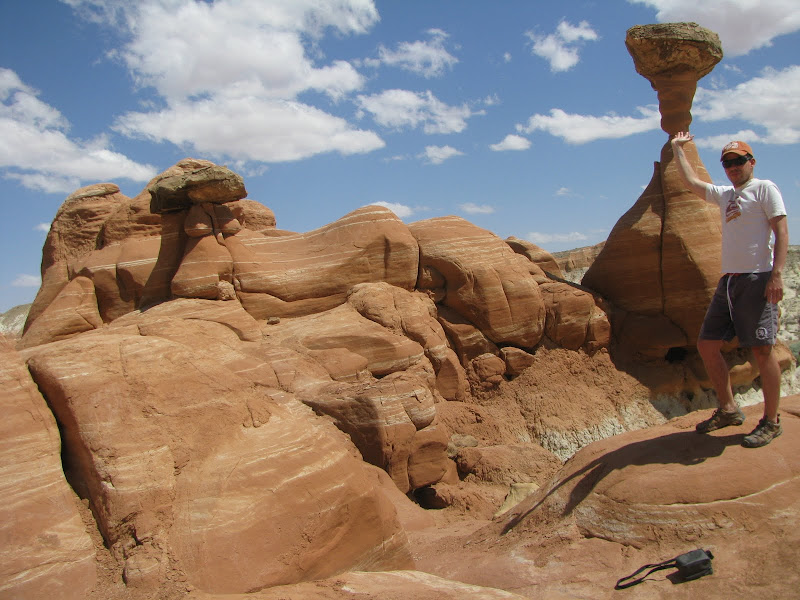A hoodoo is a tall, thin spire of rock that protrudes from the bottom of an arid drainage basin or badland. Hoodoos consist of soft sedimentary rock topped by harder, less easily eroded stone that protects each column from the elements.
basin or badland. Hoodoos consist of soft sedimentary rock topped by harder, less easily eroded stone that protects each column from the elements.
They are mainly located in the desert in dry, hot areas. In common usage, the difference between hoodoos and pinnacles or spires is that hoodoos have a variable thickness often described as having a "totem pole-shaped body." A spire, on the other hand, has a smoother profile or uniform thickness that tapers from the ground upward.
Hoodoos range in size from that of an average human to heights exceeding a 10-story building. Hoodoo shapes are affected by the erosional patterns of alternating hard and softer rock layers. Minerals deposited within different rock types cause hoodoos to have different colors throughout their height.
Hoodoos are commonly found in the High Plateaus region of the Colorado Plateau and in the Badlands regions of the Northern Great Plains (both in North America). While hoodoos are scattered throughout these areas, nowhere in the world are they as abundant as in the northern section of Bryce Canyon National Park, located in the U.S. state of Utah (see geology of the Bryce Canyon area).
scattered throughout these areas, nowhere in the world are they as abundant as in the northern section of Bryce Canyon National Park, located in the U.S. state of Utah (see geology of the Bryce Canyon area).
Hoodoos are a tourist attraction in the Cappadocia region of Turkey where houses have been carved from these formations. These rock formations were depicted on the reverse of the Turkish 50 new lira banknote of 2005-2009.
In French, they are called demoiselles coiffées ("ladies with hairdos") and a number of them are found in the Alpes-de-Haute-Provence; one of the best-known examples is the formation called Demoiselles Coiffées de Pontis.
Đavolja Varoš (Devil's Town) hoodoos in Serbia feature 202 e xotic formations described as earth pyramids or "towers", as the locals refer to them. Since 1959, Đavolja Varoš has been protected by the state, and it is also a nominee in the New Seven Wonders of Nature campaign.
xotic formations described as earth pyramids or "towers", as the locals refer to them. Since 1959, Đavolja Varoš has been protected by the state, and it is also a nominee in the New Seven Wonders of Nature campaign.
The hoodoo stones on the northern coast of Taiwan are unusual for their coastal setting. The stones formed as the seabed rose rapidly out of the ocean during the Miocene epoch. Efforts have been made to slow the erosion in the case of iconic specimens in Wanli.
The geology of areas where fairy chimneys form typically comprises a thick layer of tuff (consolidated volcanic ash), covered by a thin layer of basalt or other volcanic rocks that are more resistant to erosion than the underlying tuff. Over time, cracks in the basalt allow the much softer tuff to be eroded and washed away. Fairy chimneys are formed where a small cap or boulder of the original basalt remains, and protects a cone of tuff beneath it from erosion. Eventually, the tuff will be undercut to the extent that the cap falls off, and the remaining cone is then quickly eroded.
washed away. Fairy chimneys are formed where a small cap or boulder of the original basalt remains, and protects a cone of tuff beneath it from erosion. Eventually, the tuff will be undercut to the extent that the cap falls off, and the remaining cone is then quickly eroded.
MORE PICTURES
They are mainly located in the desert in dry, hot areas. In common usage, the difference between hoodoos and pinnacles or spires is that hoodoos have a variable thickness often described as having a "totem pole-shaped body." A spire, on the other hand, has a smoother profile or uniform thickness that tapers from the ground upward.
Hoodoos range in size from that of an average human to heights exceeding a 10-story building. Hoodoo shapes are affected by the erosional patterns of alternating hard and softer rock layers. Minerals deposited within different rock types cause hoodoos to have different colors throughout their height.
Hoodoos are commonly found in the High Plateaus region of the Colorado Plateau and in the Badlands regions of the Northern Great Plains (both in North America). While hoodoos are
Hoodoos are a tourist attraction in the Cappadocia region of Turkey where houses have been carved from these formations. These rock formations were depicted on the reverse of the Turkish 50 new lira banknote of 2005-2009.
In French, they are called demoiselles coiffées ("ladies with hairdos") and a number of them are found in the Alpes-de-Haute-Provence; one of the best-known examples is the formation called Demoiselles Coiffées de Pontis.
Đavolja Varoš (Devil's Town) hoodoos in Serbia feature 202 e
The hoodoo stones on the northern coast of Taiwan are unusual for their coastal setting. The stones formed as the seabed rose rapidly out of the ocean during the Miocene epoch. Efforts have been made to slow the erosion in the case of iconic specimens in Wanli.
The geology of areas where fairy chimneys form typically comprises a thick layer of tuff (consolidated volcanic ash), covered by a thin layer of basalt or other volcanic rocks that are more resistant to erosion than the underlying tuff. Over time, cracks in the basalt allow the much softer tuff to be eroded and
MORE PICTURES
You have read this article with the title HOODOOS. You can bookmark this page URL http://oinsweden.blogspot.com/2011/07/hoodoos.html. Thanks!
Write by:
AN - Tuesday, July 26, 2011







.jpg)


Comments "HOODOOS"
Post a Comment